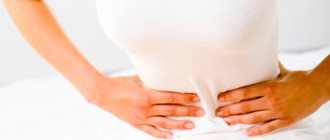Congratulations!! 20 weeks is not just half of your journey with your baby, it is the most difficult and responsible half. Starting this week, your baby’s main task is to grow well. Now he weighs approximately 270 g, and his size is about 15 cm, if measured from the crown to the tailbone and as much as 25 cm - from the heels to the crown. Your baby is approximately the size of a banana. If until half the term we indicated its size without taking into account the length of the legs, now it is already possible to measure the growth of the belly in a standard way, taking into account its entire length.
From 20-22 weeks, the beating of a small heart can already be heard using a regular tube, which the doctor places on your anterior abdominal wall. This week the first stage of the formation of the fetal lungs begins; by the end of the 22nd week the baby will be able to make the first movements with them, which will still be episodic in nature. The intestines and kidneys work well, the gonads function, the spleen functions as a hematopoietic organ. The baby now makes swallowing movements more often, training the digestive system.
By week 20, a black substance called meconium has probably formed in his intestines, which is the result of digestion of amniotic fluid. The baby will continue to produce original feces after birth, so don’t be alarmed if you see a black, sticky substance on the diapers. Occasionally, meconium may pass during labor; its presence in the waste water indicates a not very favorable course of labor.
Belly size at 20 weeks
The abdominal circumference at the 20th week of pregnancy is approximately 70-75 cm. The fundus of the uterus is two transverse fingers below the navel.
To “unload” the spine, doctors recommend performing special gymnastics for pregnant women. Water aerobics for pregnant women and fitball exercises have a very good effect. It is worth giving up shoes with heels, maintaining your posture and trying not to put stress on your back. Clothing for pregnant women should also be as comfortable as possible, preferably made from natural fabrics and without straps, elastic bands, etc. squeezing the stomach. Following these recommendations will definitely help if you have back pain during pregnancy.
Visiting an obstetrician-gynecologist
At the 20th week of pregnancy, a woman can have a scheduled appointment with a gynecologist. On the eve of the meeting, you need to take a urine and blood test (directions were issued at the last appointment). At this time, the examination is usually carried out on a chair, so you should take a pad with you.
At the appointment, the doctor will measure blood pressure, temperature, weight and abdominal volume. The gynecologist will ask about the sensations that have appeared and changes in well-being. The fetal heartbeat will be listened to using a stethoscope. Additionally, the doctor will palpate the fetus through the abdominal wall.
At the 20th obstetric week of pregnancy, many women note increased absent-mindedness and lack of concentration, so it’s a good idea to write down any questions you ask the doctor in advance so as not to forget.
At this time, a referral for a routine ultrasound and a “triple test” may be given. Most often, women who have not passed the first screening, with peculiarities of the course of pregnancy or questionable results in the first analysis are sent for an additional blood test (triple test).
Ultrasound and tests
Visit to the doctor at 20 weeks
At the 20th obstetric week of pregnancy, a woman needs to undergo urine and blood tests before admission. Urinalysis allows you to assess the quality of the urinary system and exclude hidden inflammatory processes. Finger blood tests: general and sugar, are taken to monitor the general condition of the body. These studies are an important element of monitoring the favorable course of pregnancy, so we recommend taking them on time.
Screening
A referral for an ultrasound at this stage of pregnancy is the 2nd planned screening. It is carried out to identify possible pathologies in the fetus and monitor the condition of the uterus and placenta. At this stage of pregnancy, the doctor examines:
- condition of the fetus. Measures head circumference (HC), humerus length (HBL), thigh length (HBL), head width (BPR);
- stage of fetal development: the state and degree of development of all internal organs and systems, their correspondence to the gestational age;
- location of the fetus in the uterus;
- place of attachment of the umbilical cord and placenta, their condition;
- volume of amniotic fluid.
The data obtained allow us to draw conclusions about the course of pregnancy and the presence of threats to the health of the woman and the unborn child. If inconsistencies between fetal parameters and term, pathologies of the uterus, placenta, and umbilical cord are detected, additional studies and tests may be prescribed.
If the baby turns the right way, the doctor can tell the future parents the gender of their unborn child with high accuracy.
A “triple test” at the 20th week of pregnancy is done to determine the likelihood of congenital diseases in the fetus. The levels of hCG, estriol and alpha-fetoprotein are measured in a woman's blood. Based on the data obtained, experts can predict which genetic diseases may manifest themselves. But this is not a 100% result, it only identifies risk groups for possible complications. To confirm the presence of a particular disease, it is necessary to conduct additional invasive studies (amniocentesis, cordocentesis, etc.). A woman has the right to refuse additional examinations.
Uterus and belly
At the 20th week of pregnancy, the fundus of the uterus is at the level of the navel. The standing height of the uterus is from 18 to 24 cm.
If the woman is pregnant for the first time, the number of kilograms corresponds to the permitted norms and there are no complications, then the belly at this stage looks neat, sticking forward, and stands out well above the pelvic bones.
During a second pregnancy, if up to 5 years have passed after giving birth, the belly may be different: it may be larger in size and “hang” forward a little.
Pain in the abdomen and other parts of the body
At the 20th week of pregnancy, a woman may experience unpleasant pain. It is good if a woman can promptly determine when to see a doctor and how to reduce the intensity of the symptom before taking it.
Stomach ache
The 20th week may be accompanied by unpleasant and painful sensations in the abdomen. Depending on the nature of the pain and how often it occurs, different solutions are possible:
- Uterine tone is a painful sensation in the abdomen, accompanied by tension across the entire surface. If tone appears after physical activity and stress, you need to rest: lie down and relax. The symptom has disappeared - you need to try to avoid actions or situations that provoke tone. If the situation repeats or there is constant tension over the entire surface of the abdomen, an urgent consultation with a gynecologist is needed;
- Increasing pain: intensifying when pressed, appearing crampingly, accompanied by a change in the color of the discharge or an increase in temperature above 37.5 C - a reason to urgently seek medical help;
- Pain in the right or left side, when making a sudden movement, standing or sitting, is most often caused by tension in the abdominal muscles. If the pain goes away quickly after changing body position, no treatment is required. Consult your gynecologist about the need to wear a prenatal bandage.
Back pain
At this stage of pregnancy, many women begin to experience back pain. Most often they appear in the sacrum area in the late afternoon. The appearance of this symptom is caused by increased weight and a shift in the center of gravity. The spine experiences additional stress, responding with pain in the evening. A prenatal bandage can help reduce the severity of the symptom that appears.
Severe pain localized on the right or left side of the back at the abdominal level is a symptom that requires urgent consultation with a gynecologist. This can result in problems with the functioning of the kidneys and inflammatory processes.
Pain and cramps in the legs
At the 20th week of pregnancy, your legs also experience overload. As a result, pain may appear due to various reasons: lack of vitamins, varicose veins, swelling. To determine the cause of the pain, you need to see a doctor and get tested to rule out the possibility of gestosis. You should immediately seek medical help if the pain does not go away after a night's sleep.
Headache
If a woman has a headache at 20 weeks of pregnancy, her blood pressure needs to be measured. If the readings are below 90/60 or above 140/90, you need to consult a gynecologist for advice.
If your blood pressure is normal, you can try drinking clean water and ventilating the room well. Quite often, headaches are caused by insufficient fluid or lack of oxygen. If the pain does not go away within 30 minutes, you should consult a doctor.
Discharge
Normally, at the 20th obstetric week of pregnancy, the discharge is light or milky in color and has virtually no odor. Consultations with a specialist require highlighting those with:
- red, brown, green or yellow;
- with a strong unpleasant odor;
- curdled or flaky structure;
- with pus;
- very liquid, watery.
Bleeding and menstruation
Normally, there should be no bleeding or menstruation in the 20th week of pregnancy. Any appearance of blood from the vagina is a reason to urgently seek medical help.
What unpleasant sensations may bother you at week 20?
Cramps during pregnancy are another unpleasant phenomenon that worries expectant mothers. The reason for their appearance may be a deficiency of vitamins and other microelements, since the fetus at the 20th week of pregnancy actively begins to take from the mother’s body all that is most useful for its development. In order to prevent mineral deficiency, it is recommended to take a vitamin-mineral complex designed specifically for pregnant women. However, it is better to select vitamins for pregnant women together with your doctor to avoid troubles.
To assess the progress of your interesting situation, the doctor may also order an ultrasound examination. An ultrasound at 20 weeks of pregnancy will tell you not only about how your baby is growing and developing, but also about the condition of the amniotic fluid and placenta. Some pregnant women at this stage are diagnosed with placenta previa, a pathology in which the placenta is completely or partially located in the lower segment of the uterus (in the area of the internal uterine os, i.e. on the way to the birth of the child).
Weight gain at 20 weeks of pregnancy ranges from 2.9 kg (with a BMI of more than 26) to 5.4 kg (with a BMI of less than 19.8). To calculate your individual weight gain at 20 weeks, use the pregnancy weight gain calculator.
Dietary recommendations
This part of a pregnant woman’s lifestyle is extremely important for the formation and development of the fetus. It is important to provide the child with the material to grow without gaining excess weight. Therefore, when forming a diet, you should follow the doctor’s recommendations. Most likely, he will advise building a menu primarily on light protein products, including lean meat and fish, dairy products, herbs, fruits and vegetables.
Marinades and pickles, smoked meats and fatty semi-finished products, and canned food are excluded from the expectant mother's diet. The consumption of alcohol, products with dyes and preservatives, and factory-made carbonated drinks is completely excluded.
To optimize the drinking regime, use weak tea with milk, berry fruit drinks, compote of fresh fruits and dried fruits, and clean water. A daily intake of at least 2 liters of fluid per day will help provide all the body’s needs. There is no need to be afraid that such a drinking regime will provoke swelling. Excessive salt intake is responsible for their appearance and increased blood pressure.
Salt negatively affects the condition of the walls of blood vessels and contributes to the concentration of excess fluid in the body, so the presence of salt in food should be limited. If you become overweight, you need to reconsider your diet, include more plant fiber and fewer simple carbohydrates. But complex carbohydrates will only bring benefits to a pregnant woman. They are obtained from bran bread, cereals, and legumes.
The main method of cooking is boiling, steaming, baking. Fried and smoked foods provoke heartburn and excess weight.
How the baby grows at 20 weeks
At 20 weeks the baby is about the size of a banana.
At week 20, the Baby’s height is 19-20 cm, and his weight is about 190-220 g. And also your Baby:
- knows how to gesture: connect his arms, grab the umbilical cord, touch his head - all this, as well as the Baby’s smile, can be seen on an ultrasound;
- becomes receptive to human speech - this is the sound environment that will be vital for the Baby to live in human society after birth;
- The baby’s spatial organization of the brain begins to form.
Fetus at 20 weeks of gestation
Useful advice for an expectant mother
The shortest answer to the question of how to develop a Baby before birth will be this: with love, in a good mood and every day.
Many mothers, without knowing it themselves, quietly develop their Baby during the nine months before birth. There are also those who, preoccupied with the problem of prenatal development, do more harm to the Baby than they do good. Let's imagine a Baby who has healthy genetics, his mother eats right, monitors his daily routine, rests, goes for walks, loves his baby and communicates with him - the way he knows how and in the best way possible. Is she developing it? Or does the Baby develop on his own as a result of the favorable conditions received from nature and his mother? In this case, let’s not take away our Baby’s serious victories - growth and natural (physical, mental, emotional) development. In other words, we will assume that the child develops on his own.
Of course, your loving spontaneous communication with your Baby has a developing effect. However, in order to fully feel your contribution to its development, you need to do something special, setting aside a certain time and, possibly, a place for it, and also being aware of what and why you are doing.
Our next step is to determine at what age the Baby’s development can begin. To do this, let us first remember the sequence in which his sense organs develop and reach relative maturity - they are the ones who supply the brain with signals from the external environment and are the basis for the subsequent development of movements (motor skills), orientation in space, emotions, mental processes (perception, attention, thinking, memory, speech), cognitive sphere.
- The vestibular apparatus (the organ of balance and coordination of movements) begins to develop the earliest, at 3-5 weeks, but reaches relative maturity by 24-26 weeks.
- The sense of touch begins to develop in the 7th week, becoming more and more improved every day.
- Taste: taste buds are formed at the 8th week, at the 11th week the Baby already reacts to sweet and salty tastes, and from the 18-22nd week his taste preferences are formed;
- Sense of smell: The baby is able to recognize some odors at approximately 24-26 weeks.
- Hearing: The baby is able to identify the source of sound (external or belonging to the mother’s body) at the 20th week, distinguish loud sounds at the 25-28th week, and by the 32nd he can distinguish the voices of loved ones.
- Vision is still imperfect even at the time of birth.
In the future, we will use the method of elimination to determine those sense organs that, in principle, are amenable to special development.
Tests and studies during pregnancy
“Triple test” (a blood test that determines the levels of alpha-fetoprotein (AFP), human chorionic gonadotropin (CG) and unconjugated estriol (NE) - 16-18 weeks after the first day of the last menstrual period, as indicated. These substances in a certain concentration at a certain stage of pregnancy are considered markers of certain chromosomal disorders in the fetus (in particular, Down syndrome).
Blood test for AIDS (HIV), syphilis (RW), hepatitis B - when registering for pregnancy (antenatal clinic, specialized medical center, advisory clinic at the maternity hospital etc.) These diseases can complicate the course of pregnancy and require a special approach to the management of the patient.
Analysis for blood group and Rh factor - when registering for pregnancy. If there is a risk of Rh conflict (if the woman has a negative Rh factor and the husband has a positive one), pregnancy requires special monitoring.
General and biochemical blood test, blood sugar test - when registering for pregnancy. They give an idea of the general health of the pregnant woman and possible chronic diseases.
General urine test - when registering for pregnancy, then before each visit to the doctor. Indicates the quality of kidney function.
Vaginal smear - when registering for pregnancy. Assessment of microbial flora, exclusion of urogenital infections.
Tests for urogenital infections - according to indications .
Hormone analysis - according to indications .
Visiting a doctor monitoring pregnancy: once a month. Weighing, measuring blood pressure, measuring the height of the uterine fundus, listening to the fetal heartbeat.
Visiting specialists: therapist, ophthalmologist, otolaryngologist, dentist.
ECG (electrocardiogram).
Lifestyle
Celebrate the middle of your pregnancy by going to the theater with your husband! But it’s better to avoid watching plays with heavy psychological plots—neither you nor your child need negative emotions right now, because stress hormones, according to scientists, increase a woman’s heart rate, increase blood viscosity, blood pressure, and worsen uteroplacental circulation.
You should also not attend cinemas or rock concerts - very loud and long-lasting sounds can frighten the baby and even lead to underdevelopment of his hearing aid.
Good to know
Baby's first movements: reasons for joy and anxiety
Mental development of the fetus: is it necessary to engage in prenatal education?
Can pregnant women go to the bathhouse?
Fever, cough, runny nose, headache during pregnancy
Exercises in the pool for pregnant women
How to choose a fitball for a pregnant woman
What sports are ideal for pregnant women?
How to choose the right bandage for pregnant women
Should a pregnant woman wear a brace?
All texts for pages about mother and baby were kindly provided by RAMA Publishing - these are chapters from the book by Svetlana Klaas “Your Favorite Little Man from Conception to Birth”, reviewer Irina Nikolaevna Kononova, Candidate of Medical Sciences, Associate Professor of the Department of Obstetrics and Gynecology of the Ural State Medical Academy (Ekaterinburg).
Beauty and accessories
Do you continue to go to work, but your favorite business suits have become too small for you? Fortunately, today there is a large selection of clothes for pregnant women. In specialized stores you can buy excellent suits for pregnant women. The best option is a three-piece suit (includes trousers, jacket and skirt). You can combine various shirts and tops with these wardrobe items. And stylists recommend complementing the look with fashionable accessories - glasses, capes, hair decorations, elegant gloves and bags. When choosing the color of a business suit, give preference to black and white. By the way, the black bottom can hide your “interesting position” for quite a long time - as you know, this color has the ability to “shed” several centimeters.








